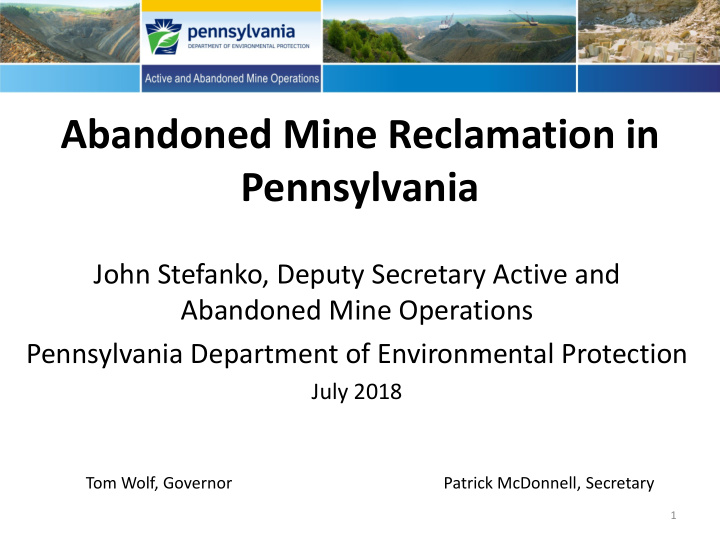



Abandoned Mine Reclamation in Pennsylvania John Stefanko, Deputy Secretary Active and Abandoned Mine Operations Pennsylvania Department of Environmental Protection July 2018 Tom Wolf, Governor Patrick McDonnell, Secretary 1
Coal Distribution in Pennsylvania • Pennsylvania mines two different types of coal; anthracite in the east and bituminous in the west. • Anthracite is a hard, compact variety of coal that has a high luster. 2
Coal Distribution in Pennsylvania • In 2017, Pennsylvania mined 7.6 million tons of anthracite coal. – Statistically no change from 2016. • Bituminous is a relatively soft coal containing a tarlike substance called bitumen. • In 2017, Pennsylvania mined 52.7 million tons of bituminous coal. – 18% increase over 2016. 3
Mine Locations in Pennsylvania 4
Mine Sites Surface non coal mines - 1,800 to 2,000 Bituminous surface coal mines – 127 Anthracite surface coal mines - 55 Anthracite refuse - 40 Bituminous underground coal mines – 39 Underground non coal mines – 15 Bituminous refuse - 14 Tourist mines and caves – 13 Underground storage facilities – 10 Anthracite underground coal mines – 8 5
Problems Caused by Past Coal Mining • There were (pre 1977) nearly 250,000 acres of land and 5,500 stream miles negatively impacted by coal mining in the state • Some of the problems caused by mining include: – Subsidence – Highwalls – Open shafts and portals – Polluted water supplies – Fires 6
Bureaus • Bureau of Mine Safety: – Inspection of all type of deep mines, equipment approvals, miner certification, emergency response. • Bureau of Abandoned Mine Reclamation: – Project development, design, contracting, and oversight of abandoned mine land and acid mine drainage projects; Commonwealth operated treatment facilities; in-house construction crews for select subsidence events and other needs. 7
Bureaus Continued • Bureau of District Mining Operations: – Permitting and inspection of coal and non coal surface sites, deep mine permitting, development and oversight of treatment trusts, MSI program support. • Bureau of Mining Programs: – Develop and implementation of policy, procedures, documents, scientific analysis, technical guidance, and statistical reporting in support of DEP's mine permitting, licensing, and compliance operations; manages MSI program. 8
Staffing and Office Locations • Total of 463 positions • Bureau of Mine Safety - 55 positions – Offices in New Stanton and Pottsville • Bureau of Abandoned Mine Reclamation – 173 positions – Offices in Ebensburg (Cambria), Wilkes-Barre, and Harrisburg – Eight Active Treatment Plants • Bureau of District Mining Operations - 208 positions – Offices in Pottsville, Philipsburg (Moshannon), Knox, New Stanton, and California • Bureau of Mining Programs - 24 positions – Located in Harrisburg • Deputy’s Office – 3 positions – Located in Harrisburg 9
Funding • Title IV, Surface Mining Control and Reclamation Act – 100% Federal – Bureau of Abandoned Mine Reclamation • Title V, Surface Mining Control and Reclamation Act/ General Fund 50-50 Ratio – Bureau of District Mining Operations – Bureau of Mining Programs • General Fund – 100% (also receives a Mine Health and Safety Administration grant) – Bureau of Mine Safety 10
Annual Work Volumes • Inspections completed – 22,000 (surface and deep) • Permits issued – 650 • Reclamation - AML Program and Government Financed Construction Contracts – Total projects – 200 to 300 – Acres reclaimed – 700 to 1,000 • AML potential problem assistance requests - 700 – AML emergency projects – 50 to 100 • MSI policies – 61,000 (total) • Miner certifications – 600 • Deep mine equipment approvals - 70 11
BAMR - Reclamation Efforts • In the last 5 years, DEP completed 1,012 abandoned mine projects and spent $120,530,700 (all sources; federal, capital budget) Year Projects Completed USD Spent 2013 195 $29,639,962 2014 224 $30,710,551 2015 195 $25,177,735 2016 172 $14,213,954 2017 226 $20,788,498 • Examples Abandoned Mine Lands – Huling Branch (2017 OSMRE National AML Reclamation Award) – Mine Subsidence – Quick Subsidence, Green Valley School – Mine Fire – Jeansville, Phillips, Renton – Abandoned Mine Drainage – Cresson Treatment Plant – 12
BAMR Active Treatment Sites Cumulative treatment impact is 107.5 miles. • A ninth plant, Cresson, will be online by the end of 2018 • and will treat approximately 21 stream miles. 13
Act 54 Report Update • November 2017 - Letter of Agreement Executed with the University of Pittsburgh • April 2018 - Kick off meeting held with University of Pittsburgh • Received requests from Citizen’s Coal Council for data – Data was sent • Reviewed Draft USGS Report on Flow Measurements in Small Watersheds • Progress made on follow up items to the 4 th Report 14
Karst Work Group • Part of Aggregate Advisory Board’s Regulation, Legislation and Technical Committee • Three meetings (most recent 7/16/18) • Discussion has focused on mining permit application materials and hydrogeologic modelling 15
Title IV SMCRA Reauthorization • Coal fees of Title IV of the Surface Mining Control and Reclamation Act expire September 30, 2021 • Fees on each ton of coal mined fund AML projects • The AML Trust Fund balance is about $2.4 billion • The existing AML inventory or projects is projected to be $4 billion • Pennsylvania has the greatest number of projects in the AML inventory 16
AML Pilot • The AML Pilot Program was authorized by Congress under the Consolidated Appropriations Act (signed by President Obama on December 18, 2015) and provides additional funding to PA’s AML Program – For FFY 2016, it was $30 million (16 projects) – For FFY 2017, it was $25 million (10 projects) – For FFY 2018, it was $25 million, accepting proposals through July • The funds are to be used “for the reclamation of abandoned mine lands in conjunction with economic and community development and reuse goals” 17
Thank you! Please contact John at jstefanko@pa.gov with any questions. 18
Recommend
More recommend